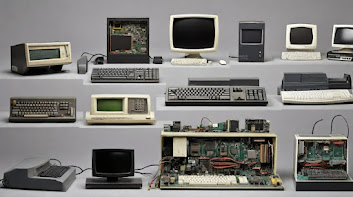HardwareHub: Your Daily Byte of Computer Essentials
Understanding the Internal Mechanisms of Computer Hardware
Welcome on the first day of our journey into the amazing world of computer hardware! Let's take a tour through the essential elements which fuel our digital world today.
1. Central Processing Unit (CPU):
The central processing unit, or CPU, reads and processes instructions from programs. Its efficiency is increased by processing data through multiple CPU cores and threads using a control unit and an arithmetic logic unit (ALU). Its processing speed is based on its clock speed, which is measured in GHz. Cache memory increases speed by storing frequently accessed data. By separating work into phases, an instruction pipeline enhances operations. CPU architectures and instruction sets are shaped by different architectures which include x86, ARM, or RISC-V. Limiting the heat produced during operation requires effective cooling systems. Although a CPU's power greatly influences performance, a computer's capabilities are also shaped by other parts like RAM and GPU.
2. Graphics Processing Unit (GPU):
The processing of photos, films, and animations is the GPU's (Graphics Processing Unit) area of expertise. It is built to manage concurrent operations, unlike the CPU, and excels at the mathematical computations required for graphics rendering. With thousands of cores, it can process data quickly and in parallel, making it perfect for computational activities like machine learning as well as gaming and entertainment. Dedicated video memory (VRAM) is a feature of high-performance GPUs, which speeds up graphics processes and frees up the CPU for other work. GPUs greatly enhance visual performance in devices ranging from game consoles to high-end workstations and super computers. They come in various builds, from NVIDIA's CUDA to AMD's Radeon.
3. Random Access Memory (RAM):
Volatile memory essential to a computer's real-time functions is Random Access Memory (RAM). It helps with quick processing by storing data that the CPU needs to access rapidly. RAM acts as quick, temporary storage that keeps running applications, used data, and the operating system organized for easy access when needed for necessary activities. Its speed, measured in MHz or GHz, impacts the functionality of the entire system. Unlike hard drives and other permanent storage, RAM loses data when it is powered off. many RAM is essential for responsive computing and smooth multitasking as it allows a system to run numerous applications at once without experiencing any kind of lag.
4. Motherboard:
An essential part of a computer that connects and coordinates components is the motherboard. In along with housing the CPU, RAM, GPU, and other peripherals, it provides PCIe buses with data transfer channels. It defines compatibility and expansion possibilities with its slots and connectors for components. Hardware initialization is handled by the BIOS or UEFI firmware on startup. Chipsets control how data travels between various components. External connections are enabled by ports for USB, Ethernet, audio, and other devices. Size and layout are determined by form factors like ATX or Mini-ITX. Because it serves as a central hub, the motherboard is important because it impacts a computer system's overall capabilities, compatibility, and performance.
5. Storage Devices:
Computer data is stored on storage media. Hard disk drives (HDDs) have large capacities but slower speeds since they store data magnetically on spinning disks. SSDs, or solid state drives, have no moving components and faster data access thanks to the usage of flash memory. SSDs are usually more expensive but are also more reliable and efficient. PCIe is used by NVMe SSDs to provide significantly quicker data transfer. Portable storage is provided by external drives such as external HDDs and USB flash drives. Cloud storage stores data remotely over the internet using programs like Dropbox and Google Drive. The speed, capacity, and portability of storage devices vary, meeting a range of requirements from daily use to high-performance computing and data backup.
Evolution of Computer Hardware
Follow the interesting path from the first computing machines to the most powerful gadgets available today. Draw attention to important turning points like the creation of integrated circuits, transistors, and the broad effects of Moore's Law.
Engaging Teaching Strategies:
We'll use visual aids to help you understand the internal workings of computers, such as infographics, animations, and diagrams. We'll cover historical chronologies, telling the fascinating story of hardware's development through pictures.
Interactive Learning Experience:
Take a test by identifying various hardware parts using the provided images or clarifications. The goal of this engaging workshop is to solidify your newly acquired knowledge!
In Conclusion
To sum up, knowing the fundamentals of computer hardware is a good starting point for exploring the wide world of technology. It serves as the foundation for subsequent investigations into more complex ideas.
Come along tomorrow as we explore the complex world of computing in more detail!








Comments
Post a Comment